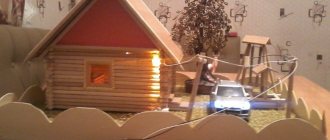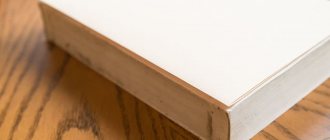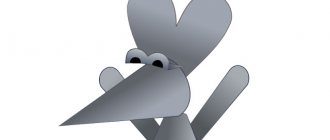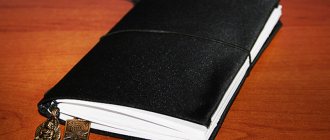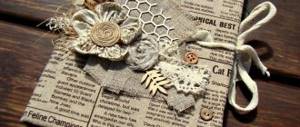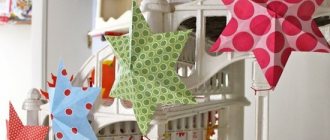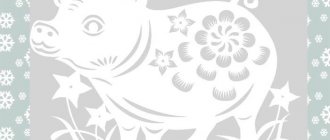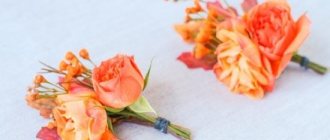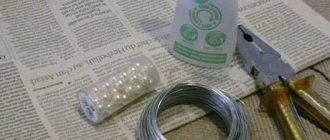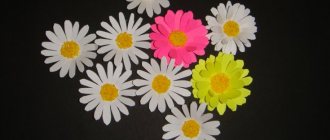Before you get down to work, decide what size you will make the album and how many sheets it will contain. Buy a draftsman's kit at the store - standard sheets of drawing paper - and make an album out of them. By purchasing such a set, you will save yourself from difficult work that requires great care and precision - cutting out sheets according to a template.
Now about the number of sheets in the album. Ten sheets are the best option. The album page must be thick, so we will glue each of the three sheets of drawing paper together. And so that two of them are with the longitudinal (lobar) direction of the fibers, and one is with the transverse direction (Fig. 1^). If you neglect this rule, the sheet will “lead” when gluing - it will bend in one direction, and the stamps will fall out from pockets. Let us recall how the direction of fibers on paper is determined. Select one sheet of paper from the pack, take it by the edges, try to bend it several times, first in the longitudinal, then in the transverse directions. In which direction the paper bends easier will be the fractional direction.
For the album you will need 30 sheets: 20 longitudinal and 10 transverse. Set the transverse sheets aside for now, and cover the lobar sheets on one side with black paper (Fig. 2). Cover the pasted sheets with sheets of thin paper, fold them into a bundle, and place thick plywood or a wide board with a small weight (1.5-2 kg) on them. While the sheets are drying, make a template to mark out the pockets. Cut out a blank from cardboard according to the format of the album sheets and mark it, as shown in Figure 3.
Mark the top and bottom on the cardboard and cut out rectangular windows (Fig. 4). Check whether the pasted sheets have dried, if everything is in order, carefully push them to one side (align them) and use the tip of scissors to make a small dent on the left side of the stack - the mark will indicate the spine area of the sheet. Then use the template. Take a sheet from the stack, align it with the sides of the template (the spine of the sheet should be on the left) and, tilting the knife at an angle of approximately 45°, make slits on the paper, as shown in Figure 5. And again fold the sheets of paper into a bundle.
Pockets for stamps should be cut out of transparent, colorless material: cellophane or tracing paper. In these materials, just like in paper, the fibers can be located in different directions. We need strips with a longitudinal direction (Fig. 6). Insert the strips into the slots of all longitudinal sheets (Fig. 7, top). Now they need to be secured with glue. First, secure one side of all the strips to all the sheets.
The same Figure 7 (below) shows how the other end of the strip is glued. Lubricate the place where the end of the strip will be glued with glue, and, slightly stretching it, press it against the sheet with your finger. Let the glue “set” and start working on another pocket. When gluing the pockets, try not to pull the strips too tight, otherwise the sheet may bend.
To finally secure the strips, glue the back side of each longitudinal sheet with thin paper, maybe newspaper {rig. 8). Arrange the sheets with paper, put them in a bundle and dry them for two to three hours under a load (Fig. 9).
The next operation is one of the most critical (Fig. 10). Place the lengthwise sheets face down, spine margins inward, into two stacks: ten in each. Prepare glue and a pack of transverse - we will call them intermediate - sheets. Take one longitudinal sheet from the pack, coat its reverse side with glue, and then carefully place the intermediate sheet on it. Smooth out the sheets to avoid wrinkles. Now take a longitudinal sheet from another pack and also coat its reverse side with glue. Carefully place it on the intermediate sheet. The remaining sheets of the album are glued together in the same way. Edge ten sheets glued from three blanks with fabric strips 14-15 mm wide (so as not to fray), line them with paper and place them under a load for one or two days (Fig. 11). When gluing, you, of course, tried to combine the parts of the blanks. To tell the truth, even experienced bookbinders do not always succeed in this job. So align the block. Push the dried pack onto the front (front margin of the block), prepare a thick ruler and a bookbinding knife. Now you need to trim the radicular field (Fig. 12). While working, try not to press on the knife; from time to time, sharpen (sharpen) it using a fine block and fine sandpaper. Take your time, rushing can only ruin things. For beginning bookbinders, if there is no press, we advise you to clamp the block at least between two thick slats.
After trimming, disassemble the block into two bundles, five sheets each. Sheets in bundles should be positioned with the spine margins inward (see Fig. 10, left). To make the album open easily, the sheets need to be glued together in pairs with strips of durable material: calico or fabric. Bookbinders call them falchiks. Figure 13 shows how the folds are edged. It is difficult to apply glue to narrow strips of fabric, so use a sheet of plexiglass (Fig. 14). Using a large brush, carefully apply an even layer of glue to the surface of the plexiglass and place the strips on it. Cover the plexiglass with paper and iron it with your palm: the strips will stick to the plexiglass. Then remove the paper and, slightly prying the strip with a knife, peel it off the plexiglass (Fig. 15).
Place the strip on the table with the adhesive surface facing up. Take a sheet from each pack and place first one, then the other on the strip as shown in Figure 16A. When gluing, try to lay them on the strip more accurately. All ten sheets are glued together using folding sheets. After gluing, you will have five double sheets. Fold each double sheet along the fold so that the edges of the pages match (the strip itself should remain inside the folded sheets). Line the pages with sheets of clean paper and let them dry. After 5-10 minutes, repeat the operation of gluing the folds, although now double (folded) sheets (Fig. 16B). You will have two notebooks left - four sheets each. They also need to be glued together with a fold (Fig. 16C), and then the last remaining double egg should be glued to the resulting block (Fig. 16D). The block is fastened, but not completely. Cut tissue paper to fit the sheets - use the template for the pockets. Place newspaper on the table and spread out (lay out) the prepared sheets of tissue paper as shown in Figure 17 A, approximately 5 mm apart.
Now coat the paper with glue. Figure 17A shows how to work with a brush. The next operation - inserting tissue paper into the block - try to do it quickly if possible, otherwise the glue will dry out and the tissue paper will warp. Glue the tissue paper end-to-end to the fold (Fig. 17B). To equalize the thickness of the block with the spine and edged front, place spacer sheets between the pages (they should fit between the folds and edges), and then glue the endpapers on top and bottom - sheets of thick paper folded in half (Fig. 18). The spacer sheets remain in the block until the end of work. It's time to glue the spine of the block. Place cardboard on both sides of the block, a weight on top and coat the spine thoroughly with glue. Before the next operation - punching out the spine - you will have to wait an hour or two until the glue dries.
As soon as the block is dry, take a mallet and begin to round (knock out) the spine (Fig. 19). The rounding of the spine gives the album a real, “book” look. First, “walk” the top edge of the spine with a mallet. When it is slightly rounded, turn the block over and repeat the operation. If both edges are rounded equally, the job is done well. To finally secure the spine of the block, stick a strip of starched gauze or a wide bandage on it. Reinforce the upper and lower edges of the spine with captals.
Work with the block is completed, move on to the binding cover. It consists of two cardboard sides, a paper backing and a covering material - calico, lederine or fabric covered on the inside. There is a lot of material about this on the Internet! We hope that Figures 21-23 will help you complete this job. Place the finished album between the cardboards and place it under a press.
First, I will cite a typical letter from Vladimir (city of Novy Urengoy).
“I read your article with interest. I am well familiar with the skills of purchasing albums and book collections. My first album, when I was a child, was the most simple and inexpensive. Class books were very expensive for me at that time. And I was happy when my mother bought me this simple stamp album. The stamps had to be affixed with a sticker. I remember carefully cutting out thin strips from the notebook, cutting them and bending them. Then he applied glue and glued it onto the album sheet, creating his first stamp collection. Only over the years did I learn that this was a barbaric destruction of stamps. The adhesives at that time were not of good quality - fungus often appeared. But most importantly - often gluing and re-gluing stamps in an album - I became infected with collecting postage stamps at the age of 10. The stamps helped me broaden my horizons in geography and understand what was depicted on the stamps - it was very interesting. About five years ago I returned to my hobby again, bought a lot of bookkeepers and clamps. Unfortunately, Chinese counterfeits are often sold under the German brand. and the sizes of the stockers do not always help to insert larger-volume products. Therefore, remembering that once, a long time ago, I saw a large album with a respectable collector - where he calmly placed not only stamps, but also large efficiency factors. Its sheets were fastened with bolts. By the way, this album was from the famous company YVERT ET TELLIER, but now they don’t make such albums. In my opinion, no one makes these anymore.
Then, having drawn up my plan, dimensions and sample album, I ordered 3 pieces to be made. (and print the sheets) in the city printing house. They did. The turner turned me the necessary parts for the albums. And I collected my albums for the collection. What I did is up to you to judge. But I tried to make the albums neat. I am sending you scans of my albums and some sheets of stamps. The photo quality is not so great. But I did not strive to take high-quality photographs of stamps, but simply to show the size of large film materials - how well they fit on the sheets. In addition, I have not yet made explanatory notes on the sheets. I look forward to your assessment of my albums.....”
Here's my answer:
I’ll say right away that not only you, but also many other collectors make similar albums “for themselves.” I will write about the pros, cons and mistakes below. But foreign companies also continue to produce similar illustrated albums, mainly based on the chronology of almost all countries of the world, but also on popular topics. These albums are built according to already established principles:
Sheets are inserted into a type folder (brackets), but until recently bolted connections were also used. The more brackets there are (there are options for 13 and even 16), the easier it is to turn the sheets. But this album is also more expensive.
This design easily allows you to expand (add) the album with sheets and change sheets. Every year, manufacturing companies release a set of new sheets of stamps issued during the year. The stamps are inserted into transparent clamps (the backing of the clamp is also transparent so that the printed stamp for insertion is visible). The material itself is slightly magnetized (electrified), which allows the plastic to better hold the brand inside.
Such company sheets contain text, usually the year and name of the issue. But there are branded albums like the English Gibbons, where more informational text is given.
Even in the world, printed books-albums are now widespread, where everything is colorfully designed and there is a lot of explanatory text, often in several languages. The Chinese have especially succeeded in this. Their albums, even without embedded stamps, are pleasant to look at and can be admired. As well as their price!!! actually free packaging for stamps!
But all these solutions that companies offer have common disadvantages. It is not possible to take independent initiative to place brands “differently”. You cannot insert varieties, small sheets or envelopes (ECD). There are intermediate solutions in the form of additional sheets without text with multi-format pockets for stamps, blocks, sheets, but they still stand out from the overall design.
For this reason, there is a need for “creativity for yourself.” The main advantages are that you can print useful reference information on sheets.
here, in a homemade album, a color printer was used, a color image was printed under each stamp (author - collector Antipov Yu. - Moscow)
album sheets are made of thick cardboard with recesses for stamps (in the form of niches). No size allowance was made. When I received this album in my hands, I did not dare to insert expensive and very expensive brands of those years into these niches.
If you have good computer skills and a color printer, you can beautifully design places for stamps, blocks, etc. But all this is painstaking work, including gluing stamps and other types of holders for philatelic material. But then the result can cause not only satisfaction from the owner, but also admiration and even envy from his friends.
this album is made on the basis of the old design of KABE albums with bolted sheets
By the way, it should be said that such design activities are “in the blood” of real collectors, who are accustomed to this due to participation in exhibitions. It is there that you need to pay close attention to the design of your exhibits. Which also affects the jury's assessment. There is a certain set of rules for how exhibits are designed. And although they are not dogma, and also change taking into account the current realities of the 21st century technology, it is still worth taking these rules into account when designing your individual collections. For example, do not overload the page with an abundance of philatelic material, but it is better to provide more explanatory text in the free space, or supplement the stamp issue with an image of the issued stamps (which is not difficult to print through a printer).
Based on your albums, I noted one significant flaw, which you yourself know and it probably “disappoints” you. This is a page fold. You have to hold them with your hand when flipping through and viewing them. There is a solution, and I have seen several homemade implementations by our craftsmen. But for this, initially the sheets are selected a little larger on the left side (where they will be fastened), and additionally “pressed” (or cut through) in place so that they can be leafed comfortably.
Well, now my REVELATION
about how to make
an album for yourself “cheaply and conveniently”
. By the way, many collectors and exhibitionists store stamps this way. Standard A4 sheets of good density are taken as a basis (even Whatman paper is possible), with the expectation that they will be “accepted” for printing by your printer. You design the collection at your own discretion using clamps, corners for attaching cards (envelopes), etc. You print headings, explanatory or reference texts, and you can also print images in places for stamps. And then you paste all this into an embedded file-folder, sold in any office supply store. Folders can contain up to 60 files. Sewn-in means without holes or clips. By the way, the paper is sold in any color; aesthetes can even use black. Although at exhibitions they prefer a beige or golden colored backing.
All this is very accessible and economical. And the impression will be created primarily from your design and the included material.
And this is an example of files with rings (not the best option) and using thin white paper. But it is the most affordable option.
Let's draw the line. The survey showed that collectors prefer branded books and the more pages the better. The explanation is simple, it’s easier and more economical. Well, we’ll tolerate the fact that some large blocks or small sheets don’t fit. And let’s dream that maybe someday colorful information albums will be produced and freely sold here at a price of one hundred rubles (that’s 10 yuan at the exchange rate).
Many philatelists who invest their money in www.inaroo.com know how difficult it is to find a good album for stamps at a fairly reasonable price: either it is very expensive or the quality is poor. And few know that stamps can be stored not only in special albums and collectors.
How to make a stamp album with your own hands?
- Cut paper to fit the size of a file or photo album page.
- On the resulting sheet, arrange the stamps in the required order and mark their position with a simple pencil. You should end up with a sheet of paper marked with rectangles marking the places for the stamps.
- Carefully remove the stamps.
- On the bottom side of each rectangle in the middle, draw a small equilateral triangle with a side length no more than a centimeter.
- Make holes in the vertices of the triangle with a thick needle.
- Using thin scissors, a scalpel or a blade, cut the two sides of the triangle; there is no need to touch the base. Instead of two sides of a triangle, you can cut an arc. You will get a small triangular or arched “tongue” that will press the stamp tightly to the sheet.
- For larger stamps or blocks, you can make more “tabs” so that the stamp or block is secured both at the bottom and at the top.
Now you can insert stamps. The completed sheet must be carefully inserted into the package page of a photo album or into a file. If the marks have moved, you can correct them with tweezers. The homemade stamp album page is ready. Two sheets are placed in one file, inside out to each other. In the photo album package, if it is not single transparent, but double - only one.
If you wish, you can paint the sheet to match the theme of the series of stamps that will be placed there. Or use thick paper with a ready-made design. Both old photographs and thick pages of old magazines are suitable for sheets.
This method allows you not only to carefully store stamps, but also to create beautiful compositions from your series. And in addition, you can make notes on the sheet if they are needed - the history of the brand, the history of the acquisition of the brand, notes about missing stamps in the series, prices and other important information. These marks can become part of the composition.
The disadvantage of such an album is difficult access to stamps. If you need to remove the stamp, you will have to take out the entire sheet - and do it very carefully. And it is not very convenient to examine the stamp through the cellophane - the cellophane must be of very good quality, completely transparent.
- A wedding is a period filled with events. You always want every moment to remain in your memory, so a handmade album can be an excellent wedding gift for yourself or a friend.
- Corrugated sheeting is a modern, practical and economical material that has a long service life, corrosion and deformation resistance, thanks to which it has gained unprecedented
- All parents know how important it is for a child to love a book, and also how important it is to educate it. You need to start studying as early as possible and it doesn’t matter at all whether the book contains a coherent story. kids
- Penoizol is one of the brands of insulation. It is based on foamed and hardened urea resin. The understanding of some people who believe that penoizol is obviously erroneous
- There are basic criteria by which electronic cigarettes are selected, and it is better to consider them in order. It is necessary to take into account the style, brand, amount of steam produced by the cigarette, the size of the
Numismatics (collecting coins and paper money) is still considered one of the most popular hobbies. Some people just like to collect old coins, while others bring the latest coins from their travels and work trips. Experienced collectors even buy the rarest coins on purpose, trying to increase their collection with the rarest specimens. In this case, sooner or later the question will arise: how to save all this wealth? Not every box or case is suitable for this purpose. A faithful friend of the philatelist and numismatist, a special album with transparent pages for storing coins or postage stamps is called a klasser. In our article we will look at how to create an album for coins and banknotes with your own hands step by step.
In special stores you can find a wide variety of albums. In most cases, it is proposed to purchase separate transparent sheets with slots for coins of various diameters or banknotes, with or without a part for signatures. However, this is an expensive pleasure, and if you do not believe that numismatics is your hobby for the rest of your life, or just want to save a little money, then the best option would be to create an album yourself.
how to make a postage stamp with your own hands
Have time to write a letter to Santa Claus. Don't know the address? Write it down!
It would seem that writing a letter is so difficult? However, it’s worth preparing a little and hurrying up, as the wizard’s time for worries begins. First you need to talk to your child (if he is already talking) and discuss the letter with him. Tell your child about who Santa Claus is, where he lives and where he gets gifts for children. It is important that the child dreams and comes up with what to tell Santa Claus. Now about the letter. Here, of course, it is important to say hello to the wizard, talk about life and, of course, share your dream. Brief composition of the letter: • greeting (for example, dear Santa Claus or dear Grandfather Frost); • indicating your first and last name (so that Moroz’s assistants do not confuse the gifts); • a brief description of your achievements over the past year (learned to swim, learned English letters, helped dad fish, etc.); • a polite request for a desired gift (it is advisable to have several gifts so that Santa Claus can choose); • in conclusion, you must definitely thank your kind grandfather and say goodbye until next year. Father Frost's address. There are many options for where to put the magic letter - on the balcony, in the refrigerator, under the pillow, under the Christmas tree. In this case, parents know exactly what the baby is expecting for the New Year and can place a gift under the Christmas tree. However, parents will have to write the answer to such a message themselves and return it to where it was left by the baby (on the balcony, under the pillow, etc.). A real answer from Santa Claus can only be received if the letter is sent according to all postal requirements (i.e. there must be an envelope and postage stamps) to the following addresses: 1. in Russia: 162340, Russia, Vologda region, Velikiy Ustyug, Santa Claus (in Russian); 2. in Finland: Santa Claus, Joulupukin kamman, 96930 Napapuri, Rovaniemi, Finland (preferably in English). The New Year's message must be sent in advance (at the beginning of December), because Santa Claus and his devoted assistants have so much work that they may simply not have time to respond to all the children in time. But childhood is a time when you really want to believe in miracles. We offer examples of letters to Santa Claus from the site https://otebe.info
Letter to Santa Claus from Vanya (10 years old) Hello Grandfather Frost, I'm waiting for you very much And I want you to bring on New Year's Eve Delicious holiday candies, Sweet tangerines And my dream - a tablet, To watch cartoons, Read good books, Learn new things And play a little In Teenage Mutant Ninja Turtles. I will try to be Polite, obedient, not lazy, not naughty, and learn better. Good Grandfather Frost, Come soon, So that I grow up happy, Believing in a magical world. Letter to Santa Claus from Katya (9 years old) Grandfather Frost, I know - You are already preparing a sleigh, So that all the obedient children, The kindest, the best, Come to visit in the New Year, Bring them gifts. Grandfather Frost, I confess that I have always failed to be obedient and diligent, but I will tell you honestly that I tried every moment to be good for my family. I sincerely apologize for my bad behavior, I promise not to be lazy, listen to my mother, study. Just when you get ready to go, don’t forget about me. And I will draw my big dream beautifully, So that you will be pleased with me And on New Year's holiday You came to my home And brought my gift. Here are examples for Santa Claus from different girls and boys, you can read them, Santa Claus will undoubtedly be happy with such sincere and good letters. Write a letter like this and Santa Claus will definitely give you a gift. *** Letter for Santa Claus from Katya (7 years old) Hello Grandfather Frost. I know that you love obedient, kind children very much and fulfill their wishes on New Year’s Day. I'm not lazy. I am learning to read, count and write, and I help my mother around the house. I try to be polite and kind. I feed animals and birds in the yard, make friends with children and share toys with them. I love cartoons about princesses, Luntik and Masha, and I also like to play with dolls and draw. Grandfather Frost, please put a fairy with wings and a beautiful pink handbag under my Christmas tree. *** Letter from Igor (8 years old) Dear Grandfather Frost, I congratulate you on the upcoming New Year. Please bring me some magical sweets from Veliky Ustyug, as well as a radio-controlled car. I promise that I will behave well, help my parents, be polite, kind, and do well in school. I will prepare for your arrival: I will decorate the Christmas tree, learn a holiday poem and prepare you a handmade gift. Be sure to come to me - I will be waiting for you. *** Letter from Alina (10 years old) Dear Santa Claus. I am already 10 years old, but I still believe in miracles and fairy tales. Thank you for giving me a mobile phone last New Year, and also for always being kind to me and making my deepest wishes come true. You are a real wizard! Santa Claus, please make sure that my parents and I are happy and never get sick, so that we have fun this New Year and Christmas and be sure to go to the village to visit my grandmother. I also really want a guinea pig as a gift. I promise that I will love her and look after her. *** Letter from Misha (9 years old) Hello Grandfather Frost! My name is Misha. I am 9 years old. I study at school in grade 3-B. I have 4 friends: Antosha, Dima, Seryozha, Nazar. Thank you for the gifts you gave me every year. I love doing math homework. I love to draw and play board games. I want you to give me a big soft toy hare for New Year. I promise that I will be a good, brave, strong and smart boy. I will study well and help my parents.
Materials we will need to create the album:
- Folder on rings (you can use any other folder made of cardboard, for example, with a binder, but the option “on rings” looks much neater)
- A sheet of paper in A4 format.
- Files for coins (you should take thick ones)
- Marker.
- Ruler.
- Soldering iron.
- Small tape
- Stationery knife.
Master class on making albums for coins
Let's start our master class by preparing a paper template; before work, you can read a book with recommendations. Make a stencil on a sheet of paper in A4 format using a ruler and marker
, which is similar to a mesh cell. Each cell will contain one coin (in this case, different cells can be of different sizes, it all depends on the copies in your collection). In this case, you need to know that the size of each cell should be slightly larger than the size of the coin that will need to be placed there.
Slowly attach the finished stencil to a special file using tape.
Heat up the soldering iron and slowly trace each of the cells along the contour
– polyethylene should stick together in places of heating, but no through holes should form. If you are starting to work with a soldering iron for the first time and feel awkward, it is better to work on a rough file or sheet before doing so.
Take a stationery knife (it should be very sharp) and cut each cell
along the top edge. You need to cut from the back side of the file, carefully observing the work so that the knife does not cut through the front side. We will have slots in which we will need to insert coins.
Let's invest coins
in the slot.
Let us remember that before placing the items in the album, they must be thoroughly cleaned using lemon acid or a special cleaning agent.
Cover the slits completely
on the other side of the file.
So we created our album for coins from a sheet - we made a good storage for all the items in the collection.
It is worth noting that to create an album for coins using the above method, almost no complex equipment is required, with the possible exception of a soldering iron. Is it possible to work without it? Of course, there is another method.
Types of custom design
Creating brands is a challenge for designers, because an idea needs to be realized in a minimal area. Unusual shapes and materials help with this.
The most common shapes are rectangle (horizontal or vertical orientation) and square, which look harmonious on standard envelopes. Stamps are also triangular, trapezoidal, round, diamond-shaped, octagonal and free-form (for example, following the contours of a country or some symbol).
For printing, paper is most often used, sometimes resorting to various effects: stamping, including foil, fluorescence, varnishing. But there are other ways to stand out, such as printing on silk, gold or wood.
We have selected the top 8 most unusual postage stamps for inspiration.
- The Swarovski brand, together with the Austrian postal service, decorated the swan stamp with the famous crystals.
- The UK's Royal Mail decided to surprise stamp lickers by giving them the taste of chocolate - milk, dark and white. They were supplied in an original set in the form of chocolate bars.
- In Portugal, one of the symbols of the country, the balsa tree, was used to decorate the envelope.
- For the European Football Championship, the Austrian post office produced a stamp that looked and felt like a soccer ball.
- One of the country's brands was presented in an original way in Brazil. The brand smells like coffee, as it is coated with a special composition containing particles of coffee beans.
- Another unusual example of coating is meteorite dust, which in Austria was applied to a stamp using a special glue.
- In Bhutan, they created a real work of art - mini-gramophone records with folk songs and a story about the kingdom.
- In Austria, a traditional craft was presented in an original way by releasing a series of embroidered stamps.
